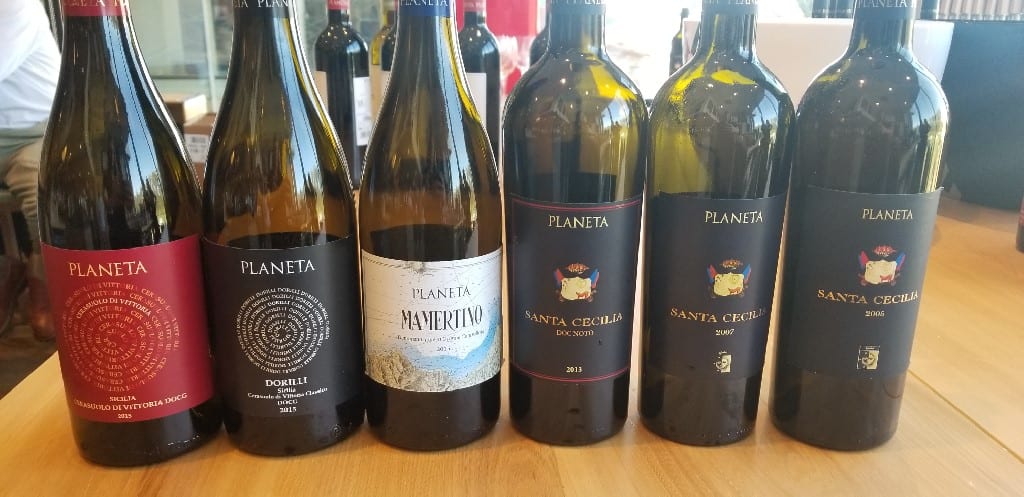

18 Oct Nero d’Avola, the Flagship Grape of Sicily
There are many wine regions in the world known for one or two flagship varieties. Burgundy is Pinot Noir and Chardonnay, Piemonte is Nebbiolo, Tuscany is Sangiovese, Napa is Cabernet Sauvignon and so on. In Sicily, the flagship grape is Nero d’Avola and I had the privilege to explore this grape through the wines from Planeta which I shared in a recent column in the Napa Valley Register and you can it read here.
In Italy, more than 80 percent of the grapes grown are native varieties. One of the most cultivated indigenous varieties is Nero d’Avola, the flagship red grape of Sicily. It makes up 60 percent of Sicily’s agriculture. When speaking about Nero d’Avola from Sicily, it is like speaking about Nebbiolo from Piedmont, Sangiovese from Tuscany and Montepulciano from Abruzzo.
One of the leading producers of Nero d’Avola is Planeta. The Planeta family in Sicily dates back five centuries and 17 generations. After a long history in agriculture, Grandfather Vito Planeta transformed their small family winery into a large cooperative winery in the 1900s.
His son, Diego Planeta, continued the evolution and was key in the winemaking renaissance of Sicily. Today, two different generations, made up of brothers and sisters, children, nieces and nephews, run the family business which includes the wine production, olive oil production and hospitality.
Alessio Planeta, who was recently in town, shared the idea that “there is not one Sicily, there are many.” From north to south, east to west, the climate and soil are different across Sicily and Planeta is expressing the diversity of Sicily through Nero d’Avola.
Planeta has 400 hectares of vines in five areas of Sicily – Menfi, Vittoria, Noto, Capo Milazzo and Etna. Nero d’Avola, which can be found primarily along the coast, is grown in all of them except Etna because the grape does not perform well on mountains. Each of these areas offers different terroirs, and Nero d’Avola is expressed differently, as I learned in a recent tasting.
Menfi
Located in the southwest of Sicily, Menfi is an agricultural area. The soils are clay-calcareous and the Nero d’Avola from Menfi is lively and succulent, expressing notes of plum, chocolate and mint.
Planeta La Segreta Nero d’Avola ($15) – 100 percent Nero d’Avola, this wine is light bodied with notes of ripe fruit and earth. It has soft tannins and bright acidity and is the perfect pizza wine.
Vittoria
The only DOCG in Sicily, Cerasuola di Vittoria, is located in Vittoria in the south of Sicily. The area has red sandy soils with flat terraces that run from the sea to the mountains. Both Nero d’Avola and Frappato are grown in Vittoria. The Nero d’Avola from Vittoria is playful and juicy with fresh strawberry and cherry notes.
Planeta Cerasuolo di Vittoria 2015, Cerasuolo di Vittoria DOCG ($23.99) – A blend of 60 percent Nero d’Avola and 40 percent Frappato, the wine has aromas of roasted strawberries, cherry and minerality with delicate tannins, medium acidity. The wine has a long finish that lingers on the palate.
Planeta Dorilli 2015 Cerasuolo di Vittoria, Classico DOCG ($32.99) – A blend of 70 percent Nero d’Avola and 30 percent Frappato, this wine has notes of strawberry jam, cherry and herbal notes with soft acidity and soft tannins.
Noto
Located in the southeast of Sicily, Noto is an area of extreme conditions. Calcareous white soils and little rain results in low vigor but intense wines with aromas of black currant, carob, incense and balsamic.
Planeta di Santa Cecilia ($40.99) – The 100 percent Nero d’Avola wine is Planeta’s top Nero d’Avola and is about elegance, power and balance. The current release is the 2013, an elegant wine with notes of black currant and carob and slightly drying tannins. The 2007 has a beautiful nose of stewed fruits and balsamic, with medium acidity and a long finish. The 2005 has lost much of its fruit and spice stands out. The older vintages are still available in the market.
Capo Milazzo
Located in the north of Sicily, Planeta has eight hectares planted in the alluvial soils. The Nero d’Avola from Capo Milazzo is fresh and velvety and shows notes of black cherry, citrus, tamarind and seaweed.
Planeta Mamertino 2015, Mamertino DOC ($32.99)—Composed of 60 percent Nero d’Avola and 40 percent Nocera, the wine has notes of dark red fruit, sweet tobacco, cedar and tamarind and is soft, velvety and lingers on the tip of the tongue.
Read the original story in the Napa Valley Register.







